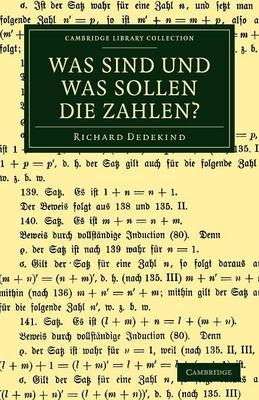
Was sind und was sollen die Zahlen?
Seiten
2012
Cambridge University Press (Verlag)
978-1-108-05038-8 (ISBN)
Cambridge University Press (Verlag)
978-1-108-05038-8 (ISBN)
What are the real numbers? In this influential 1888 book (reissued here in its 'second, unaltered' 1893 edition), Richard Dedekind (1831–1916), showed how to resolve this problem starting from elementary ideas. His method of constructing the reals from the rationals (the Dedekind cut) remains central to this day.
The nineteenth century saw the paradoxes and obscurities of eighteenth-century calculus gradually replaced by the exact theorems and statements of rigorous analysis. It became clear that all analysis could be deduced from the properties of the real numbers. But what are the real numbers and why do they have the properties we claim they do? In this charming and influential book, Richard Dedekind (1831–1916), Professor at the Technische Hochschule in Braunschweig, showed how to resolve this problem starting from elementary ideas. His method of constructing the reals from the rationals (the Dedekind cut) remains central to this day and was generalised by Conway in his construction of the 'surreal numbers'. This reissue of Dedekind's 1888 classic is of the 'second, unaltered' 1893 edition.
The nineteenth century saw the paradoxes and obscurities of eighteenth-century calculus gradually replaced by the exact theorems and statements of rigorous analysis. It became clear that all analysis could be deduced from the properties of the real numbers. But what are the real numbers and why do they have the properties we claim they do? In this charming and influential book, Richard Dedekind (1831–1916), Professor at the Technische Hochschule in Braunschweig, showed how to resolve this problem starting from elementary ideas. His method of constructing the reals from the rationals (the Dedekind cut) remains central to this day and was generalised by Conway in his construction of the 'surreal numbers'. This reissue of Dedekind's 1888 classic is of the 'second, unaltered' 1893 edition.
Vorwort; 1. Systeme von Elementen; 2. Abbildung eines Systems; 3. Aehnlichkeit einer Abbildung; 4. Abbildung eines Systems in sich selbst; 5. Das Endliche und Unendliche; 6. Einfach unendliche Systeme; 7. Grössere und kleinere Zahlen; 8. Endliche und unendliche Theile der Zahlenreihe; 9. Definition einer Abbildung der Zahlenreihe durch Induction; 10. Die Classe der einfach unendlichen Systeme; 11. Addition der Zahlen; 12. Multiplication der Zahlen; 13. Potenzirung der Zahlen; 14. Anzahl der Elemente eines endlichen Systems.
| Erscheint lt. Verlag | 2.8.2012 |
|---|---|
| Reihe/Serie | Cambridge Library Collection - Mathematics |
| Zusatzinfo | Worked examples or Exercises |
| Verlagsort | Cambridge |
| Sprache | englisch |
| Maße | 140 x 216 mm |
| Gewicht | 120 g |
| Themenwelt | Mathematik / Informatik ► Mathematik ► Analysis |
| Mathematik / Informatik ► Mathematik ► Geschichte der Mathematik | |
| ISBN-10 | 1-108-05038-7 / 1108050387 |
| ISBN-13 | 978-1-108-05038-8 / 9781108050388 |
| Zustand | Neuware |
| Haben Sie eine Frage zum Produkt? |
Mehr entdecken
aus dem Bereich
aus dem Bereich
Buch | Softcover (2024)
De Gruyter Oldenbourg (Verlag)
59,95 €


